Post by ferrari512s on Mar 4, 2014 23:16:22 GMT -5
Ultimate Hot Wheels Cars|Channel C00236562
1964 Dodge Charger Concept Car
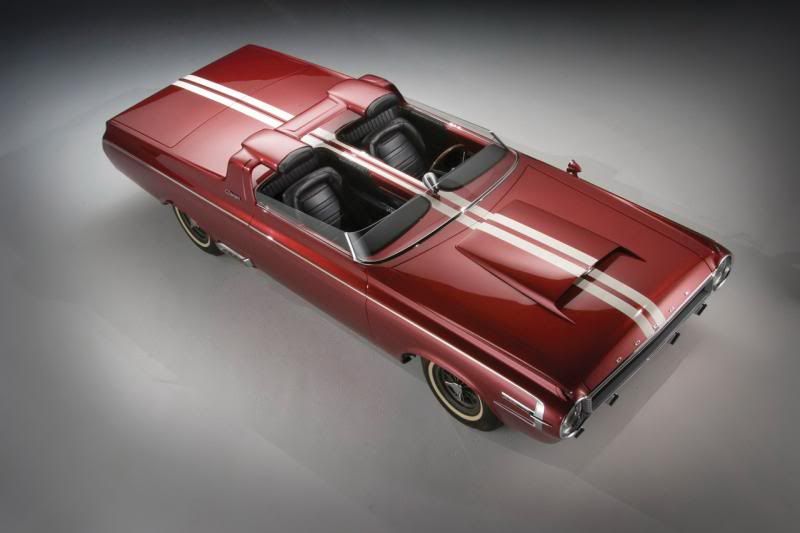
The Dodge 'Charger' name is synonymous with 'muscle car'.
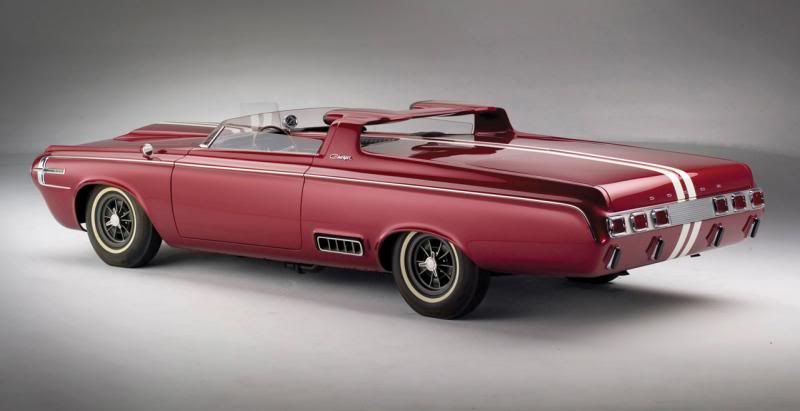
Though beaten off the line by Pontiac and their 'GTO', Chrysler was already making plans of their own that would not merely catch up, but, would blow the competition away.
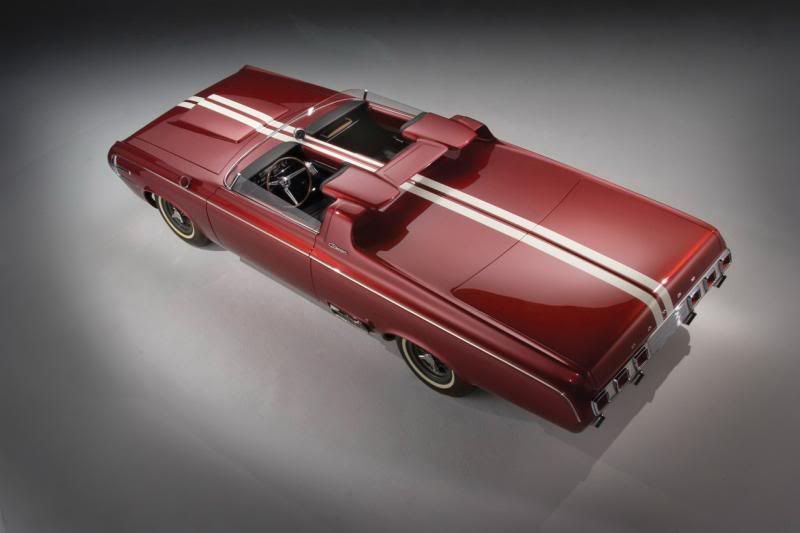
Of course, today, the Dodge Charger is one of a number of muscle cars.

But the car that introduced the 'Charger' name to the world was anything but ordinary.
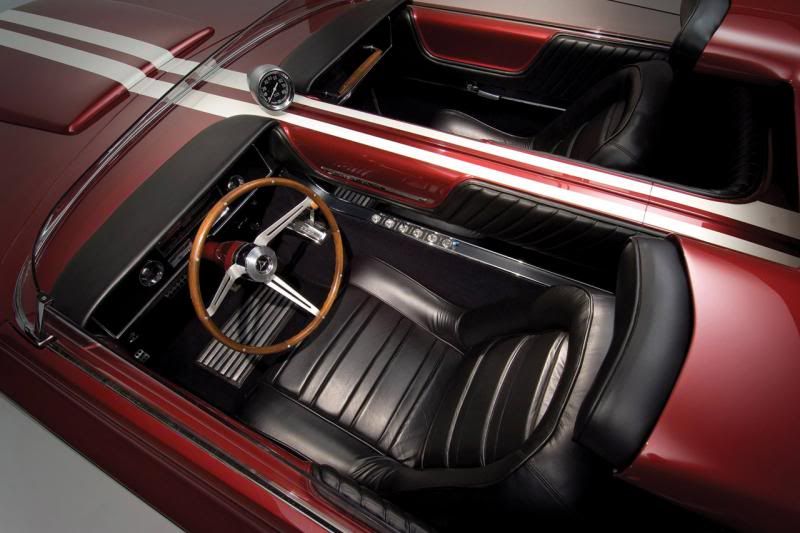
Initially the plan was to have a concept created to be a platform for the new 426 cubic inch 'Hemi' V-8 engine.
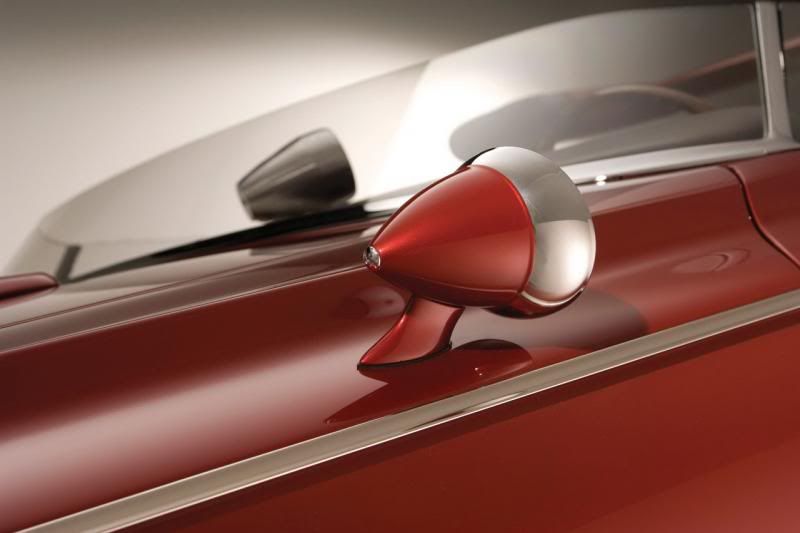
But not just any platform would do. The concept needed to convey to the public the radical horsepower the Hemi V-8 provided.
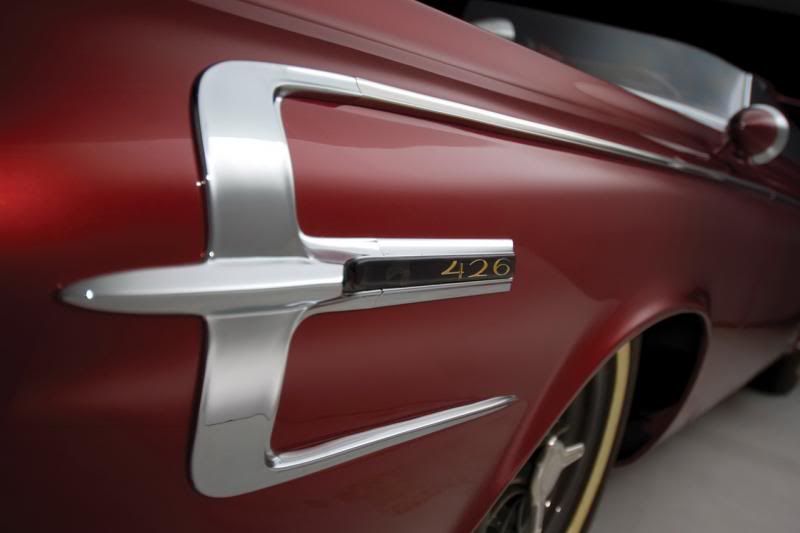
What Chrysler's design team engineered was equally radical.
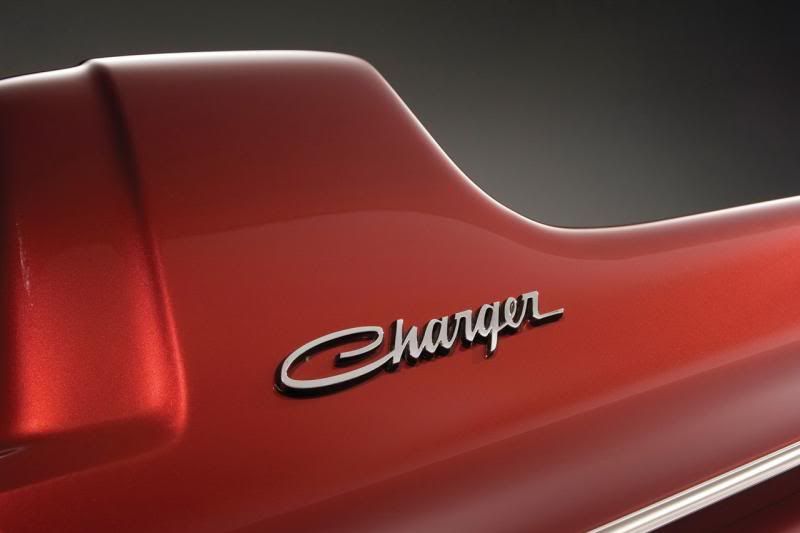
Throughout the 1950s, many concept cars were merely rolling models.

They were literally 3-D canvases; works of art on display, but never intended to actually function.
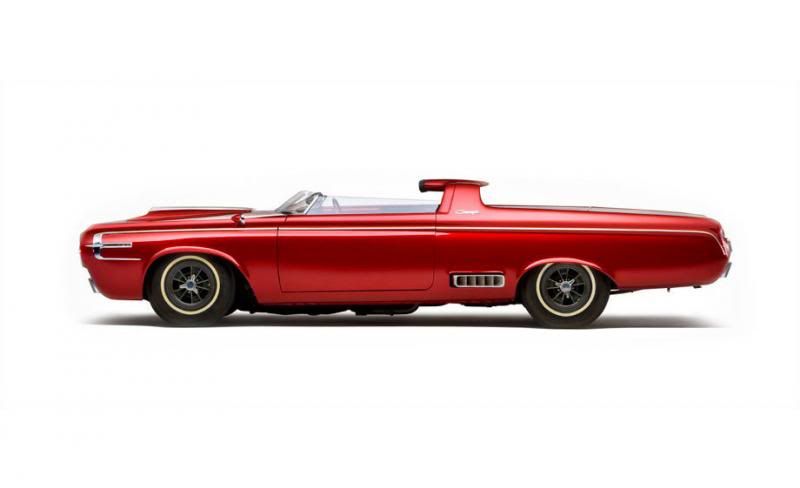
Chrysler's design team intended to change that. They were intent on showing the public a Dodge Charger fit for one's imagination.

They set out to design a concept, the supreme idea, of what the Charger could and would be.
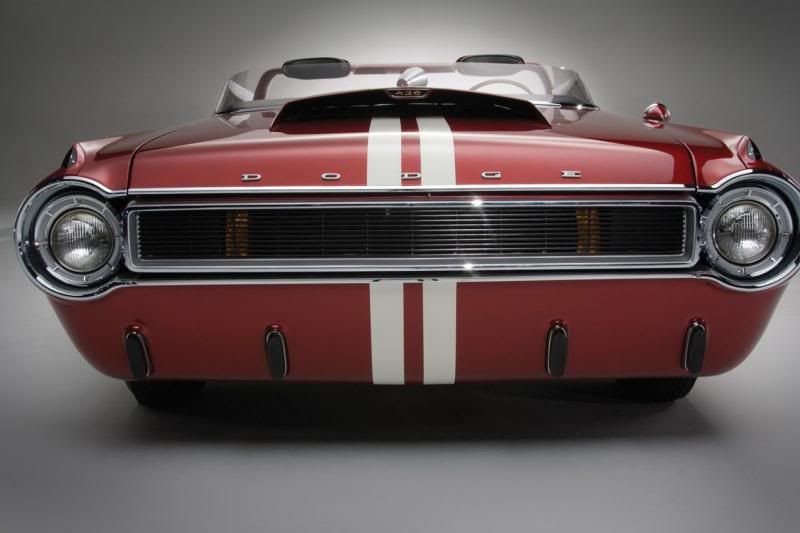
Many concept cars are not imagined out of thin air, but have something as a source of inspiration. A designer can be captivated by a shape or the way sunlight strikes something in nature or in modern structures.

An artist can even be inspired by a word. For Chrysler's design team, the word was 'Polara'.
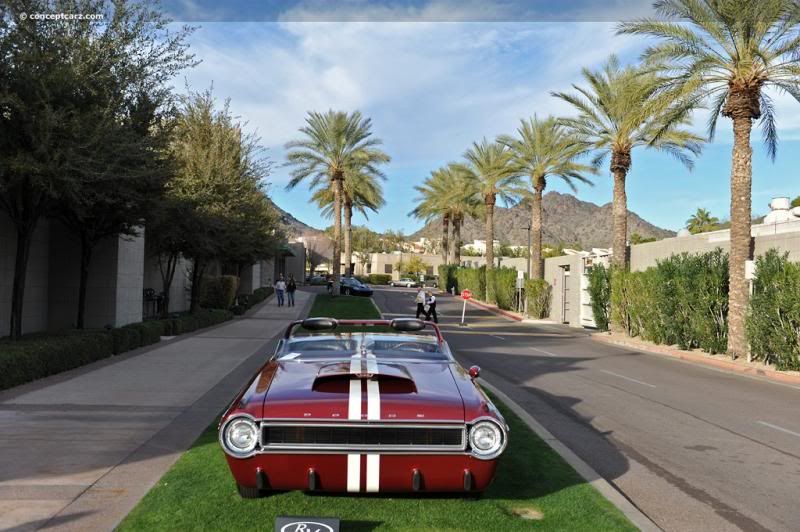
The company's Polara wasn't, however, the fulfillment of what the team had been imagining.

The car would only serve as a baseline model, from which would be built the team's expression of a Dodge 'Charger'.
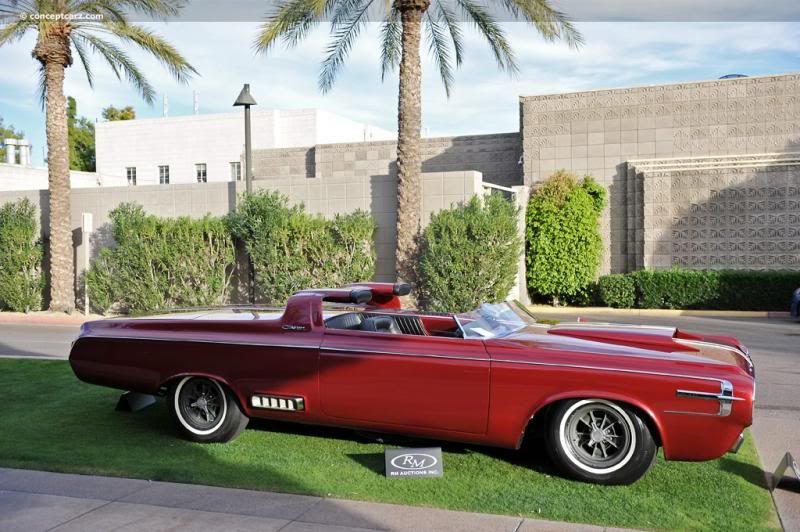
Much of the stock components in the Polara were removed and forgotten.
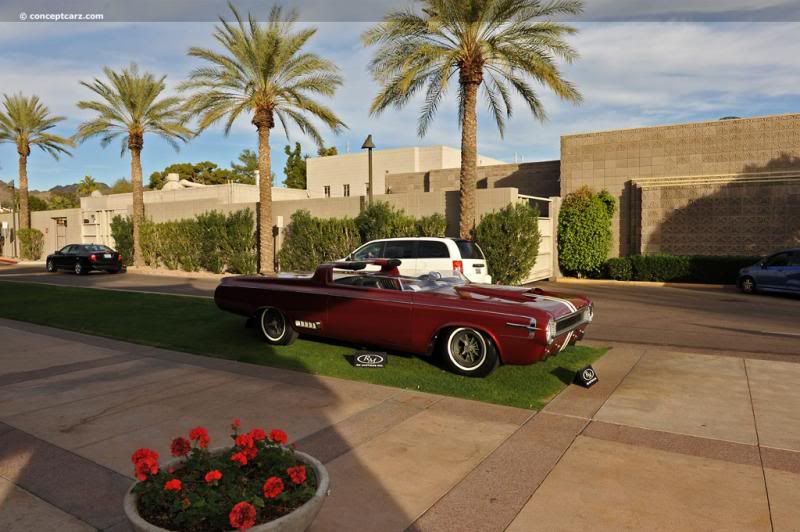
The car's bumper was replaced by a single, rolled pan with four, small rubber bars.
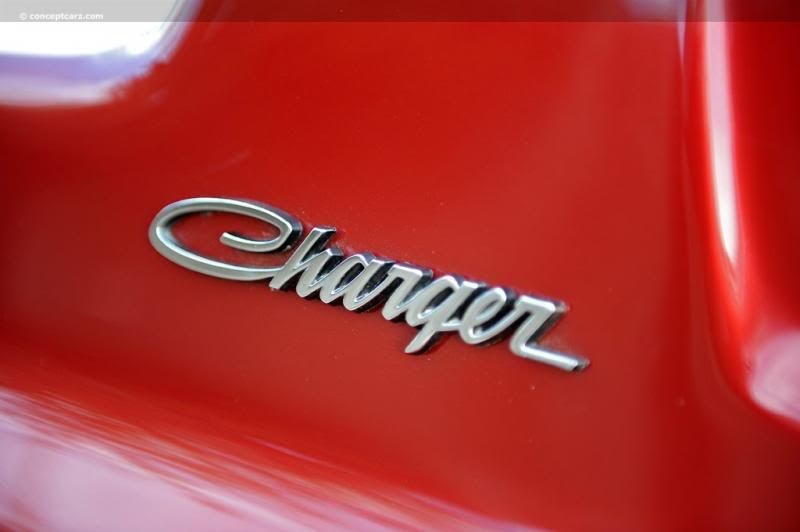
The grille was replaced with a straight hand-built unit. The Polara's inner high-beam lights were removed.
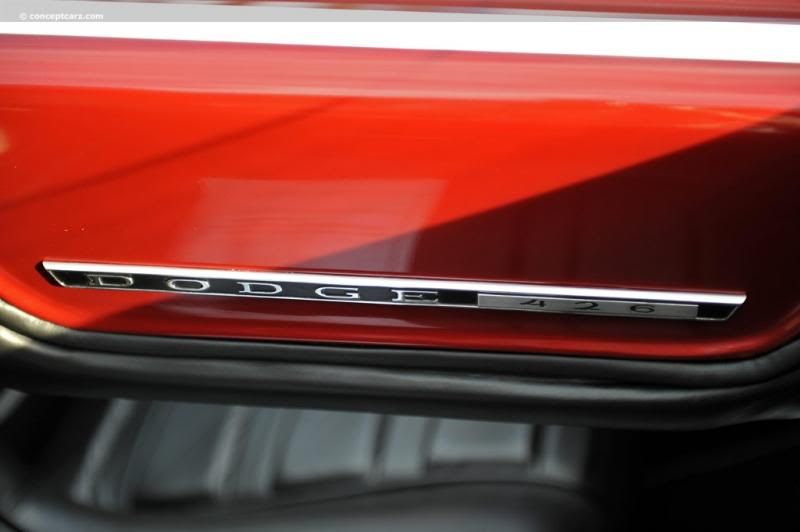
The larger, single light remained. The vane running from the top of the headlight cover and back toward the rear of the car remained but was accented much more, creating a higher, box-style rear deck.
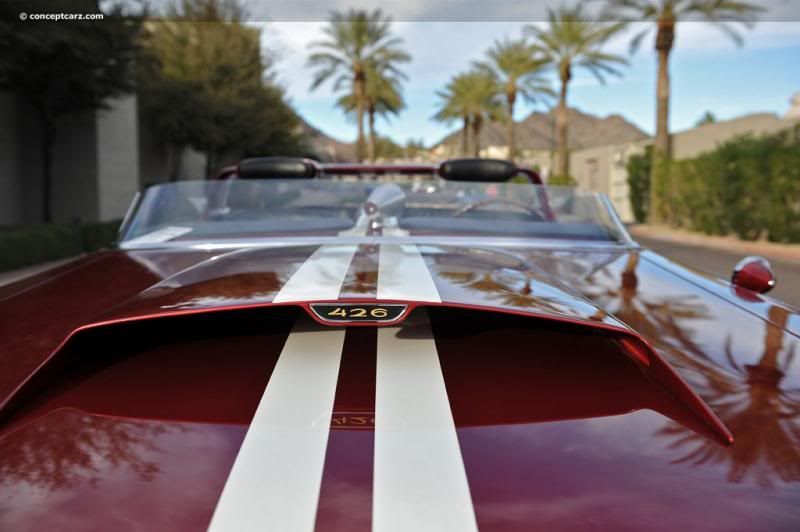
The hoodline was contoured slightly and a functional cold-air scoop was added to the top of the hood.
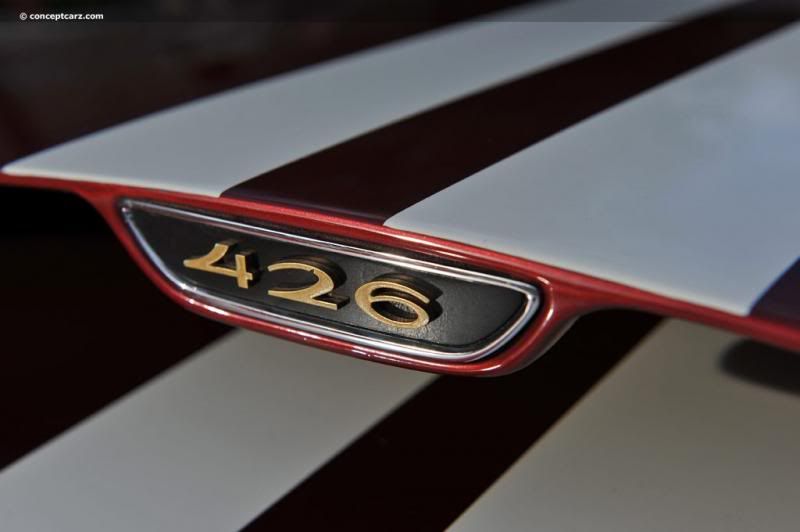
The upper-line of the headlight cover, along the side of the doors and all the way back to the rear deck was lowered.

Body side-trim was reduced, but the result still gave the on-looker a hint of the Polara's basic outline.
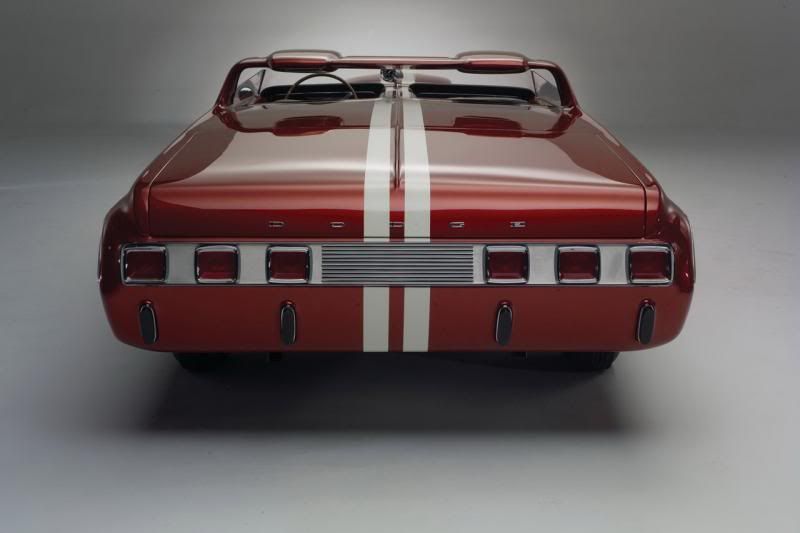
As had been done at the front of the car, the rear bumper was also removed in favor of rubber bars.
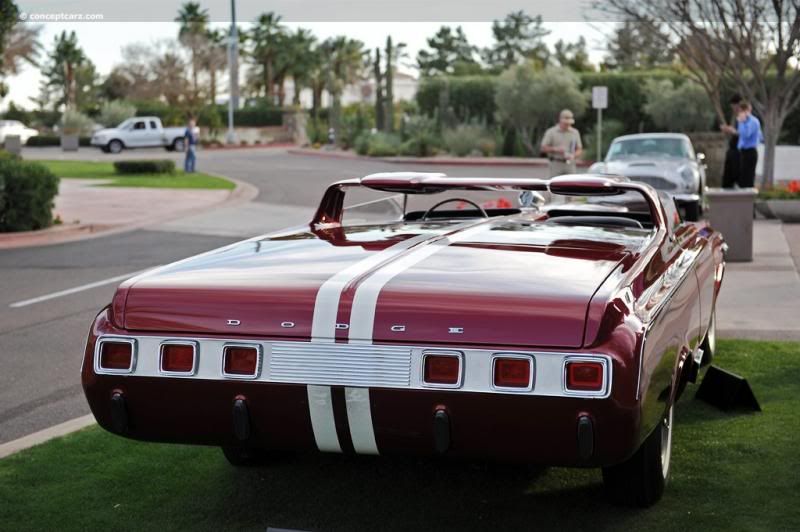
Stock taillights were used, but were spread further apart. One of the other aspects from the Polara that was retained was the DODGE letters across the top of the hood.
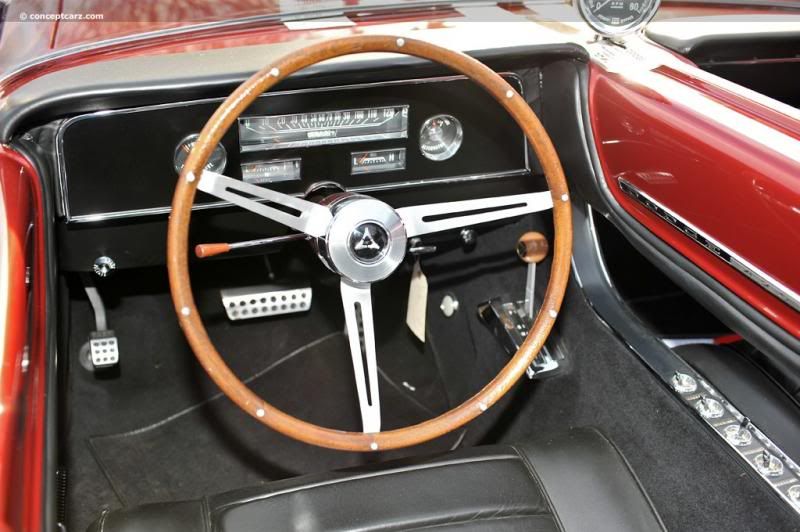
While the outside of the car still had many similarities with the Polara, from which the concept had been fashioned, the interior had practically no connection at all.
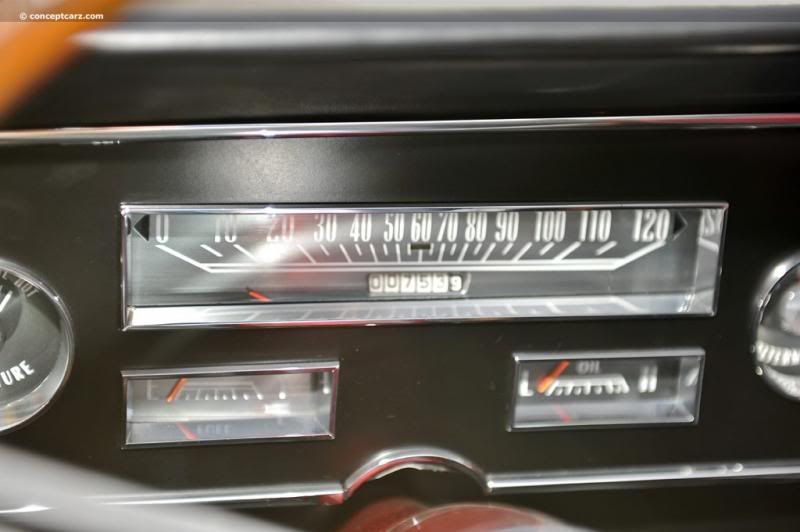
The entire interior compartment had been custom-crafted.

The car had been transformed into an incredible two-seat design, complete with a special low-cut wraparound windscreen and an incredible roll-bar/headrest combination.
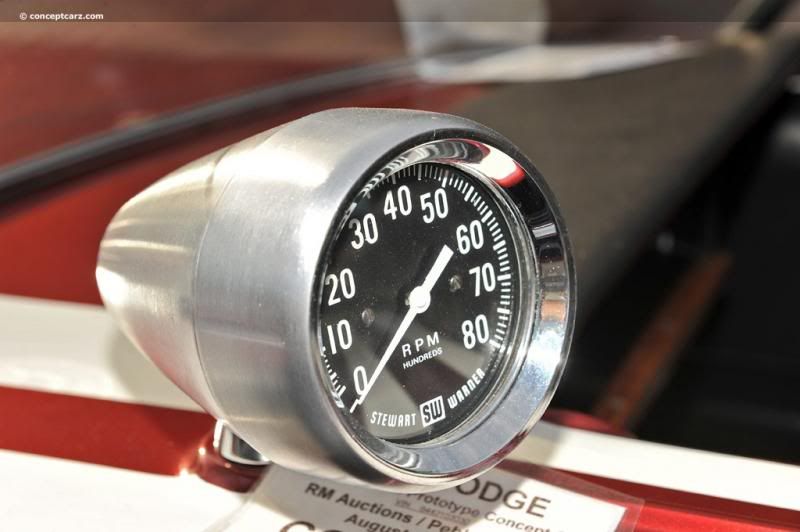
The instrument display, for the most part, was taken just as it would have appeared in the Polara with the exception of an 8,000 rpm tachometer.
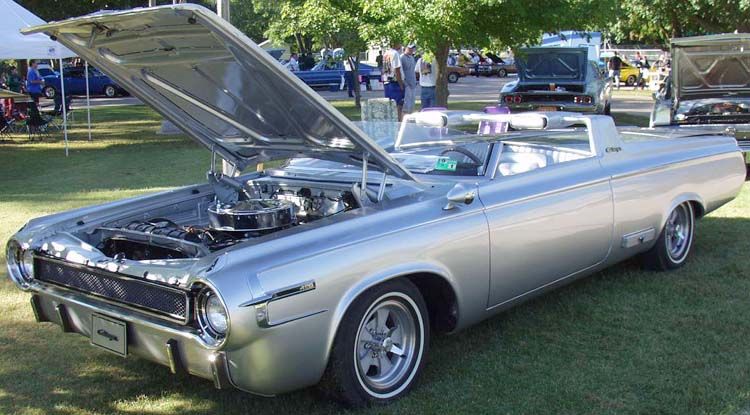
The specially made dark charcoal leather bucket seats were separated by a James Bond-like padded divider that housed many of the controls on the center console.
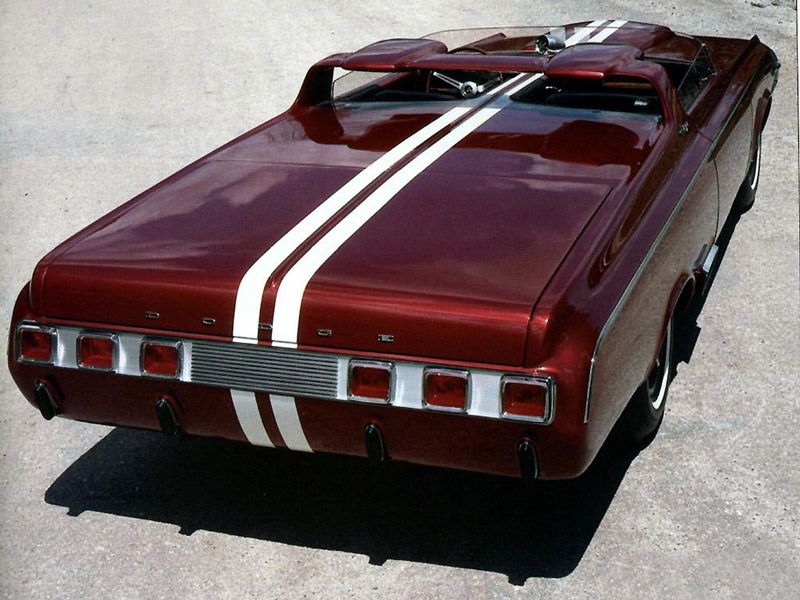
In reflection to times of the past, the three-spoke steering wheel was finished with a walnut wood trim.

While under 48 inches tall, the Charger concept was anything but small.

Its low height and wide stance made it an aggressive and mean looking car.
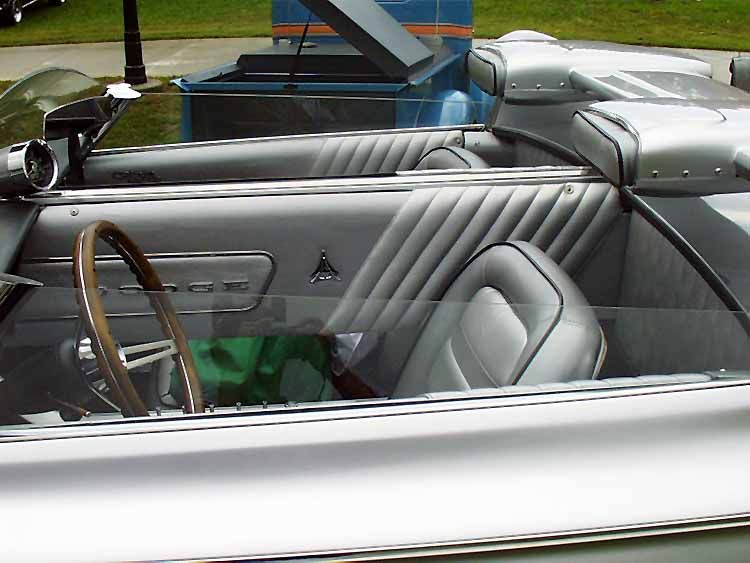
While the car was all dressed up for the ball, its purposed mode by which it was to get there left it at home with nowhere to go.
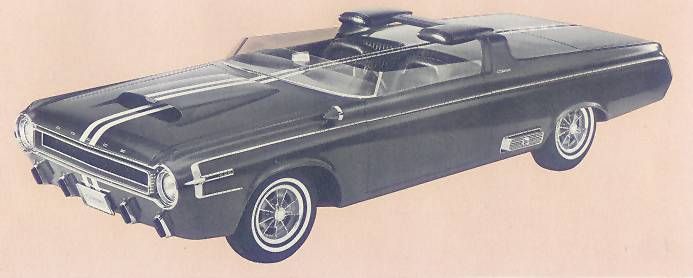
As the date for the unveiling neared, Chrysler's design team ran into a very real problem. The car was intended to showcase the all-new, specially-built, V-8 Hemi engine, but none could be found.
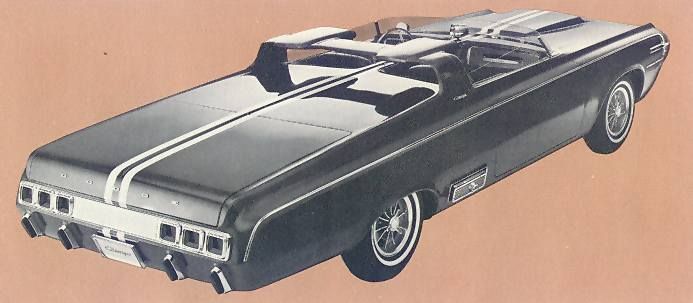
The one meant to be put inside the concept had to go to one of Chrysler's racing teams after it blew one of them.
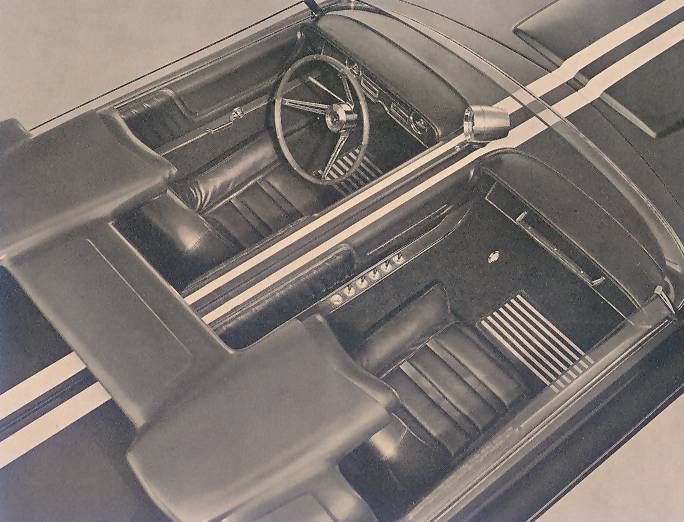
Running out of time, the team put the Polara's 305 horsepower 383 cubic inch V-8 back in and closed the hood. Amazingly, the Dodge Charger Concept went to the ball without its most important date.
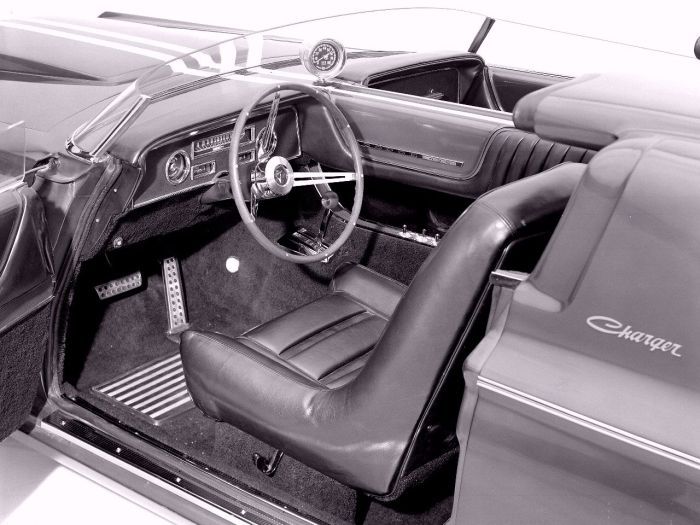
The car was taken all over the country, and although the badge said 426 on it, that was not the engine sitting under the hood.
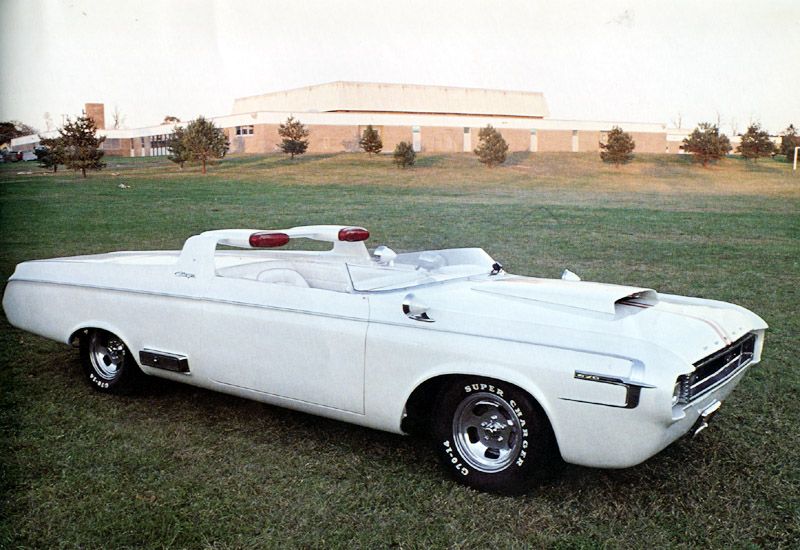
Never was the hood raised. Chrysler had gotten away with one. Soon, the concept would get away with one as well.
Most concept cars end up being destroyed and scrapped. This one would end up being saved from the chopping block by a Pennsylvanian Dodge dealer.
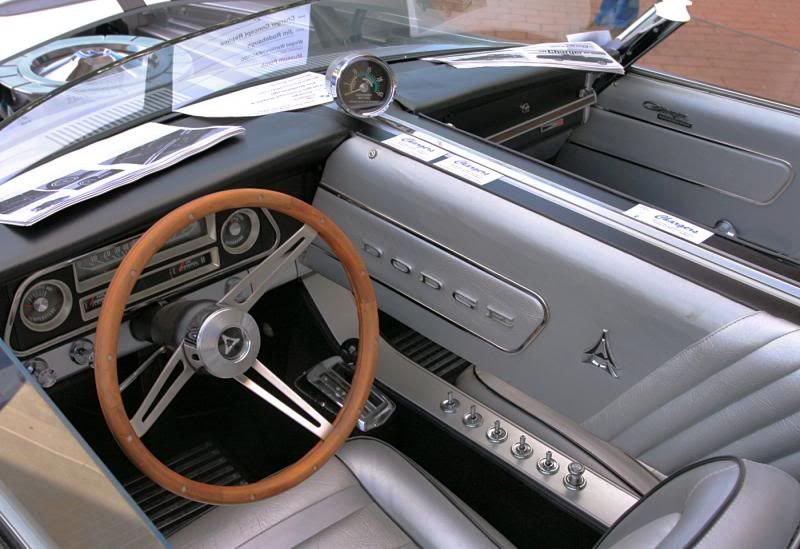
Eventually, the dealer passed the car on to his son. The car was effectively stored away for over 30 years until concept and show car collector Joe Bortz located it in 1999.
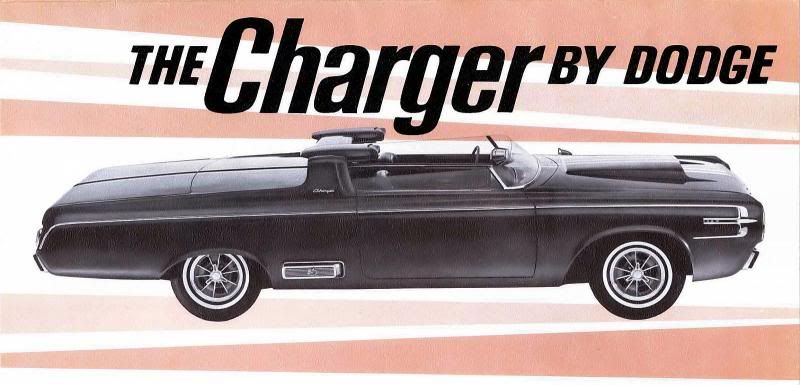
After negotiating the sale, Mr. Bortz began the journey of restoring this classic concept car.

Mr. Bortz turned to famous restorer and detailer Fran Roxas to help locate period-correct Halibrand wheels.
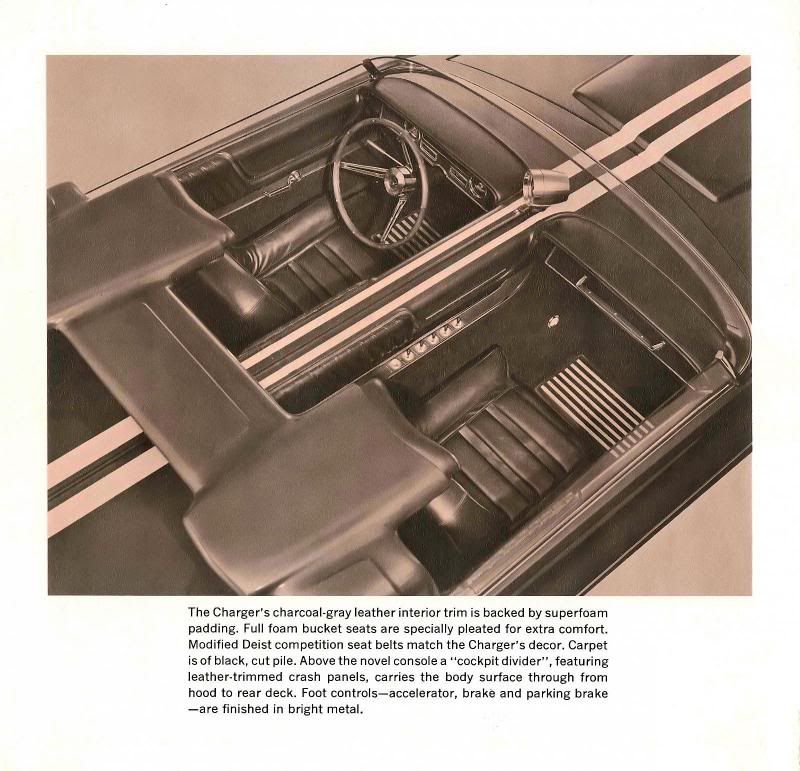
Halibrand had initially crafted special wheels used on the Charger concept.

Surprisingly, Roxas was able to locate the necessary wheels and helped to build some momentum in the project.
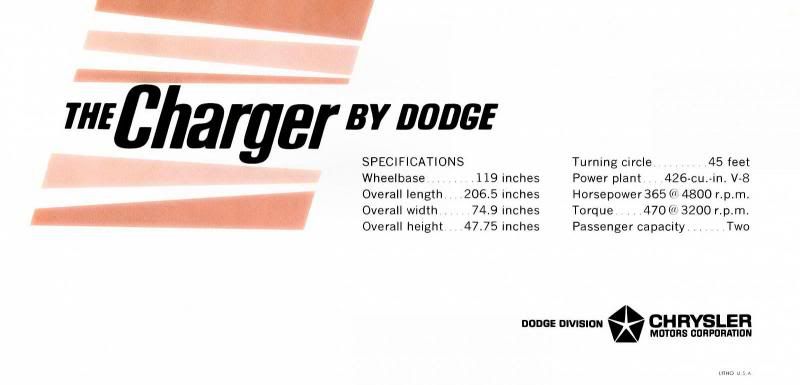
The wheels were particularly difficult pieces in the restoration puzzle, but, by being able to locate and purchase wheels in good condition, the whole project received a boost of confidence.
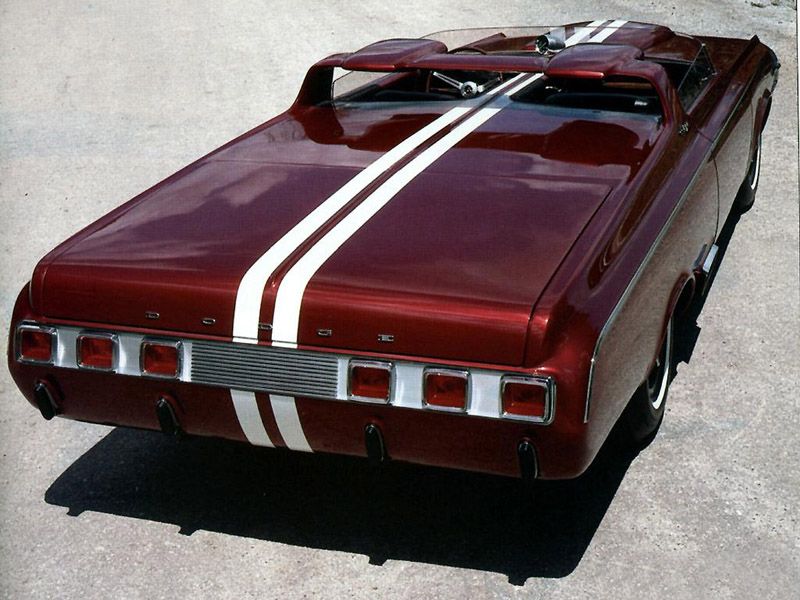
Of course, perhaps one of the most important quests in the journey was to actually try and re-unite the car with one of the handcrafted V-8 Hemi engines originally intended to sit inside and power it.
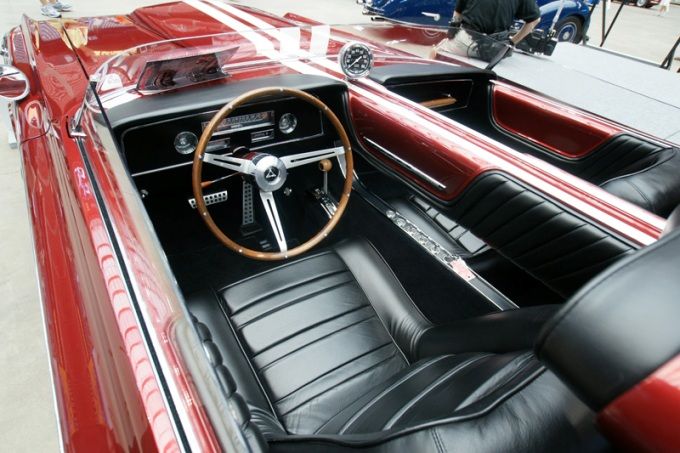
Mr. Bortz turned to Hemi expert John Arruzza for his help.
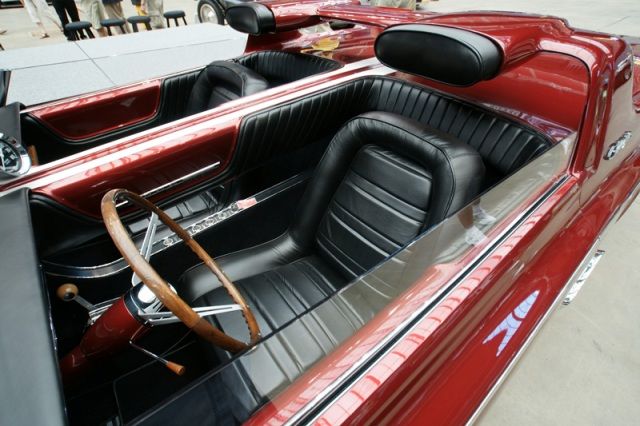
Sparing no cost, Arruzza was able to locate one of the original fifteen racing Hemi engines.
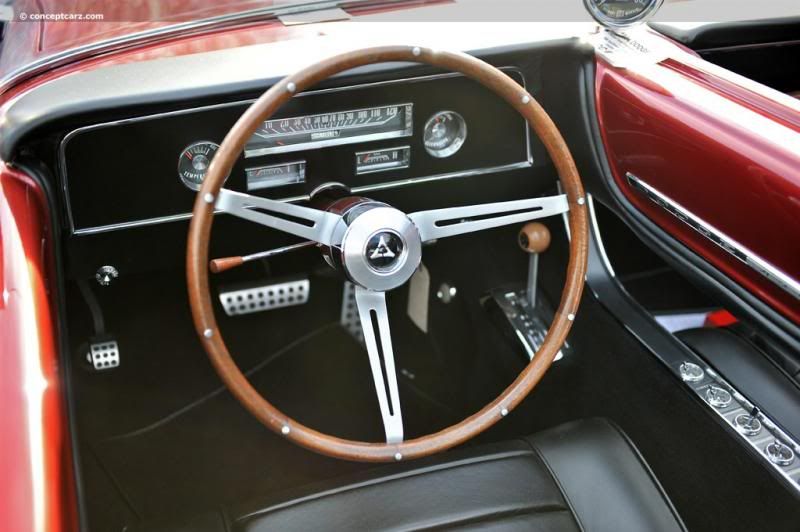
It even came with a pair of original 1964 NASCAR-spec Hemi heads and vintage Holley four-barrel carburetor.
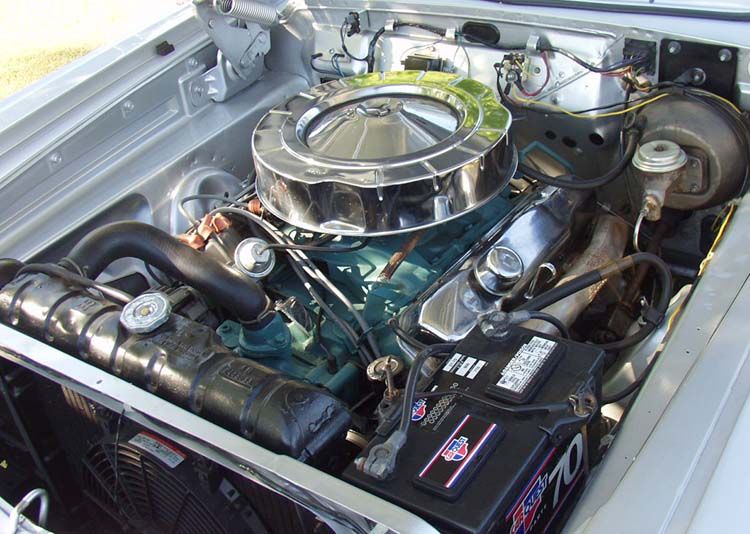
When the project was finally completed, the 1964 Dodge Hemi Charger Concept Car was able to proudly wear its 426 badge. After nearly 40 years the two were mated up. This time, the car roared to life with an engine capable of delivering over 600 bhp!

With its three-speed automatic transmission, independent torsion bar front and rear semi-elliptic lead spring suspension, a 'Sure-Grip' rear axle, four-wheel hydraulic drum brakes and all on a 119 inch wheelbase, finally the whole concept, the whole motive had come together!

In 2007, the car became part of the John M. O'Quinn collection and has been operated sparingly. Now, in 2011 the car became available for purchase again. As it appeared for the auction the car is finished in a striking dark-red finish with double-white pinstripes running the length of the car. At the 2011 RM Auction sale in Arizona, it was expected to fetch between $750,000 to $1,000,000.

But no matter what the price, it was truly remarkable to be able to have in existence, not only the concept car that was debuted before the public almost 50 years ago, but that it did so in complete form. Perhaps this time, more so than it had before, the 1964 Dodge Hemi Charger Concept Car fulfills its role as the concept car Chrysler always intended the public to witness. It is as if this were Chrysler's latest retro muscle car. For only now, had the public witnessed the complete vision, the full glimpse, of the company's incredible muscle car.

Sources:
www.conceptcarz.com/z19424/Dodge-Hemi-Charger-Concept.aspx
'Buy: Featured Lots (Lot 264: 1964 Dodge Hemi Charger Concept Car)', (http://www.rmauctions.com/FeatureCars.cfm?SaleCode=AZ11&CarID=r182). RM Auctions Arizona. www.rmauctions.com/FeatureCars.cfm?SaleCode=AZ11&CarID=r182. Retrieved 5 January 2011.
'Cars: 1964 Dodge Hemi Charger Concept', (http://www.topspeed.com/cars/dodge/1964-dodge-hemi-charger-concept-ar102797.html). TopSpeed: No Boring Cars. www.topspeed.com/cars/dodge/1964-dodge-hemi-charger-concept-ar102797.html. Retrieved 5 January 2011.
Further article on...
1964 Dodge Charger Roadster Concept

Debuted at the Milwaukee Auto Show on November 16-24 1963, the new Charger roadster stole the show at the Dodge exhibit. The customized competition roadster stands only 47 3/4-inches high, and is based on a standard Dodge convertible. Chrysler engineers utilized the basic body panels in order to maintain a close relationship between the Charger roadster show car, and standard production vehicles.

Chrysler Corporations vice president and director of styling, Elwood Engel stated, "The Charger’s styling speaks Dodge." "Our design gives this specialty car a youthful, "get-up-and-go" appearance which reflects the Dodge image as an all-out, dependable performer."

The design of the Charger required the removal of the bumpers, wheels, body mechanisms, seats, and top. Not only did this lighten the new Charger, but also provided a starting point for the stylist to begin their design for a sleek competition roadster. With the removal of the front and rear bumpers, stylist added lower valances with a set of four small bumper guards. In order to maintain an aggressive and wide grill, single seven inch headlights were used. New magnesium Halibrand wheels were mounted with special Goodyear Wingfoot high performance tires. The rear wheel-wells were designed to accept wider rim and tire combinations for drag racing.

Atop the long hood sits a Ramcharger scoop. The addition of the scoop forced cool outside air to be inducted into the 426 Cid Wedge engine. Initially the Charger was fitted with a single 4 barrel carburetor, but the hood design allowed for modifications to accept twin four barrel carburetors. The exhaust used "lake-type" headers for competition use, and by using cover plates, the exhaust gases could be directed through regular dual mufflers for street use.

The windshield is only six inches high, and combines with the lowered side glass to create a competition appearance. The rear rollbar covers the conventional rear seating area, while the integrated headrest provides comfort and support to the occupants. The interior seating and trim is upholstered in charcoal gray leather, combined with a complementary black cut pile carpet that covers the floor, the majority of the side panels, and cowl section. The twin bucket seats are fully padded, and have special pleats to increase comfort. The occupants are secured into the buckets with matching Deist competition seatbelt-harness.

The Charger features a full length console and upper "cockpit divider". The divider is leather trimmed, and features an 8000 RPM tachometer mounted high at eye-level. The deep-dish steering wheel, passenger grab rail, and the gear-shift selector are all made of walnut. The walnut is a deep contrast for the bright metal trim used on the accelerator, brake, and parking brake pedals.

Based on the 1964 Dodge Polara convertible, the Charger specialty show car featured cut down windshield, rollbar with built-in headrests, hood scoops; side rectangular exhausts ports, and a 365 horsepower, 426 cubic inch V-8 engine. The custom Charger rolled on Halibrand magnesium wheels were wrapped in Goodyear Wingfoot high performance tires. Inside the charcoal-gray leather 2-seat cockpit, the Charger featured a deep dish, walnut wood steering wheel, wood gear shift selector handle and passenger grab handle. Mounted at eye-level atop the unique divider between the seats was an 8,000-rpm tachometer.

Sources:
www.carstyling.ru/en/car/1964_dodge_charger/
fabwheelsdigest.blogspot.ca/2013/06/1964-dodge-charger-roadster-concept.html
www.allpar.com/model/early-dodge-charger.html
oldcarbrochures.org/NA/Chrysler_Corporation_and_Concepts/1964-Dodge-Charger-Concept-Folder/1964-Dodge-Charger-Concept-Folder-01
Ultimate Hot Wheels Cars|Channel C00236562
1964 Dodge Charger Concept Car

The Dodge 'Charger' name is synonymous with 'muscle car'.

Though beaten off the line by Pontiac and their 'GTO', Chrysler was already making plans of their own that would not merely catch up, but, would blow the competition away.

Of course, today, the Dodge Charger is one of a number of muscle cars.

But the car that introduced the 'Charger' name to the world was anything but ordinary.

Initially the plan was to have a concept created to be a platform for the new 426 cubic inch 'Hemi' V-8 engine.

But not just any platform would do. The concept needed to convey to the public the radical horsepower the Hemi V-8 provided.

What Chrysler's design team engineered was equally radical.

Throughout the 1950s, many concept cars were merely rolling models.

They were literally 3-D canvases; works of art on display, but never intended to actually function.

Chrysler's design team intended to change that. They were intent on showing the public a Dodge Charger fit for one's imagination.

They set out to design a concept, the supreme idea, of what the Charger could and would be.

Many concept cars are not imagined out of thin air, but have something as a source of inspiration. A designer can be captivated by a shape or the way sunlight strikes something in nature or in modern structures.

An artist can even be inspired by a word. For Chrysler's design team, the word was 'Polara'.

The company's Polara wasn't, however, the fulfillment of what the team had been imagining.

The car would only serve as a baseline model, from which would be built the team's expression of a Dodge 'Charger'.

Much of the stock components in the Polara were removed and forgotten.

The car's bumper was replaced by a single, rolled pan with four, small rubber bars.

The grille was replaced with a straight hand-built unit. The Polara's inner high-beam lights were removed.

The larger, single light remained. The vane running from the top of the headlight cover and back toward the rear of the car remained but was accented much more, creating a higher, box-style rear deck.

The hoodline was contoured slightly and a functional cold-air scoop was added to the top of the hood.

The upper-line of the headlight cover, along the side of the doors and all the way back to the rear deck was lowered.

Body side-trim was reduced, but the result still gave the on-looker a hint of the Polara's basic outline.

As had been done at the front of the car, the rear bumper was also removed in favor of rubber bars.

Stock taillights were used, but were spread further apart. One of the other aspects from the Polara that was retained was the DODGE letters across the top of the hood.

While the outside of the car still had many similarities with the Polara, from which the concept had been fashioned, the interior had practically no connection at all.

The entire interior compartment had been custom-crafted.

The car had been transformed into an incredible two-seat design, complete with a special low-cut wraparound windscreen and an incredible roll-bar/headrest combination.

The instrument display, for the most part, was taken just as it would have appeared in the Polara with the exception of an 8,000 rpm tachometer.

The specially made dark charcoal leather bucket seats were separated by a James Bond-like padded divider that housed many of the controls on the center console.

In reflection to times of the past, the three-spoke steering wheel was finished with a walnut wood trim.

While under 48 inches tall, the Charger concept was anything but small.

Its low height and wide stance made it an aggressive and mean looking car.

While the car was all dressed up for the ball, its purposed mode by which it was to get there left it at home with nowhere to go.

As the date for the unveiling neared, Chrysler's design team ran into a very real problem. The car was intended to showcase the all-new, specially-built, V-8 Hemi engine, but none could be found.

The one meant to be put inside the concept had to go to one of Chrysler's racing teams after it blew one of them.

Running out of time, the team put the Polara's 305 horsepower 383 cubic inch V-8 back in and closed the hood. Amazingly, the Dodge Charger Concept went to the ball without its most important date.

The car was taken all over the country, and although the badge said 426 on it, that was not the engine sitting under the hood.

Never was the hood raised. Chrysler had gotten away with one. Soon, the concept would get away with one as well.
Most concept cars end up being destroyed and scrapped. This one would end up being saved from the chopping block by a Pennsylvanian Dodge dealer.

Eventually, the dealer passed the car on to his son. The car was effectively stored away for over 30 years until concept and show car collector Joe Bortz located it in 1999.

After negotiating the sale, Mr. Bortz began the journey of restoring this classic concept car.

Mr. Bortz turned to famous restorer and detailer Fran Roxas to help locate period-correct Halibrand wheels.

Halibrand had initially crafted special wheels used on the Charger concept.

Surprisingly, Roxas was able to locate the necessary wheels and helped to build some momentum in the project.

The wheels were particularly difficult pieces in the restoration puzzle, but, by being able to locate and purchase wheels in good condition, the whole project received a boost of confidence.

Of course, perhaps one of the most important quests in the journey was to actually try and re-unite the car with one of the handcrafted V-8 Hemi engines originally intended to sit inside and power it.

Mr. Bortz turned to Hemi expert John Arruzza for his help.

Sparing no cost, Arruzza was able to locate one of the original fifteen racing Hemi engines.

It even came with a pair of original 1964 NASCAR-spec Hemi heads and vintage Holley four-barrel carburetor.

When the project was finally completed, the 1964 Dodge Hemi Charger Concept Car was able to proudly wear its 426 badge. After nearly 40 years the two were mated up. This time, the car roared to life with an engine capable of delivering over 600 bhp!

With its three-speed automatic transmission, independent torsion bar front and rear semi-elliptic lead spring suspension, a 'Sure-Grip' rear axle, four-wheel hydraulic drum brakes and all on a 119 inch wheelbase, finally the whole concept, the whole motive had come together!

In 2007, the car became part of the John M. O'Quinn collection and has been operated sparingly. Now, in 2011 the car became available for purchase again. As it appeared for the auction the car is finished in a striking dark-red finish with double-white pinstripes running the length of the car. At the 2011 RM Auction sale in Arizona, it was expected to fetch between $750,000 to $1,000,000.

But no matter what the price, it was truly remarkable to be able to have in existence, not only the concept car that was debuted before the public almost 50 years ago, but that it did so in complete form. Perhaps this time, more so than it had before, the 1964 Dodge Hemi Charger Concept Car fulfills its role as the concept car Chrysler always intended the public to witness. It is as if this were Chrysler's latest retro muscle car. For only now, had the public witnessed the complete vision, the full glimpse, of the company's incredible muscle car.

Sources:
www.conceptcarz.com/z19424/Dodge-Hemi-Charger-Concept.aspx
'Buy: Featured Lots (Lot 264: 1964 Dodge Hemi Charger Concept Car)', (http://www.rmauctions.com/FeatureCars.cfm?SaleCode=AZ11&CarID=r182). RM Auctions Arizona. www.rmauctions.com/FeatureCars.cfm?SaleCode=AZ11&CarID=r182. Retrieved 5 January 2011.
'Cars: 1964 Dodge Hemi Charger Concept', (http://www.topspeed.com/cars/dodge/1964-dodge-hemi-charger-concept-ar102797.html). TopSpeed: No Boring Cars. www.topspeed.com/cars/dodge/1964-dodge-hemi-charger-concept-ar102797.html. Retrieved 5 January 2011.
Further article on...
1964 Dodge Charger Roadster Concept

Debuted at the Milwaukee Auto Show on November 16-24 1963, the new Charger roadster stole the show at the Dodge exhibit. The customized competition roadster stands only 47 3/4-inches high, and is based on a standard Dodge convertible. Chrysler engineers utilized the basic body panels in order to maintain a close relationship between the Charger roadster show car, and standard production vehicles.

Chrysler Corporations vice president and director of styling, Elwood Engel stated, "The Charger’s styling speaks Dodge." "Our design gives this specialty car a youthful, "get-up-and-go" appearance which reflects the Dodge image as an all-out, dependable performer."

The design of the Charger required the removal of the bumpers, wheels, body mechanisms, seats, and top. Not only did this lighten the new Charger, but also provided a starting point for the stylist to begin their design for a sleek competition roadster. With the removal of the front and rear bumpers, stylist added lower valances with a set of four small bumper guards. In order to maintain an aggressive and wide grill, single seven inch headlights were used. New magnesium Halibrand wheels were mounted with special Goodyear Wingfoot high performance tires. The rear wheel-wells were designed to accept wider rim and tire combinations for drag racing.

Atop the long hood sits a Ramcharger scoop. The addition of the scoop forced cool outside air to be inducted into the 426 Cid Wedge engine. Initially the Charger was fitted with a single 4 barrel carburetor, but the hood design allowed for modifications to accept twin four barrel carburetors. The exhaust used "lake-type" headers for competition use, and by using cover plates, the exhaust gases could be directed through regular dual mufflers for street use.

The windshield is only six inches high, and combines with the lowered side glass to create a competition appearance. The rear rollbar covers the conventional rear seating area, while the integrated headrest provides comfort and support to the occupants. The interior seating and trim is upholstered in charcoal gray leather, combined with a complementary black cut pile carpet that covers the floor, the majority of the side panels, and cowl section. The twin bucket seats are fully padded, and have special pleats to increase comfort. The occupants are secured into the buckets with matching Deist competition seatbelt-harness.

The Charger features a full length console and upper "cockpit divider". The divider is leather trimmed, and features an 8000 RPM tachometer mounted high at eye-level. The deep-dish steering wheel, passenger grab rail, and the gear-shift selector are all made of walnut. The walnut is a deep contrast for the bright metal trim used on the accelerator, brake, and parking brake pedals.

Based on the 1964 Dodge Polara convertible, the Charger specialty show car featured cut down windshield, rollbar with built-in headrests, hood scoops; side rectangular exhausts ports, and a 365 horsepower, 426 cubic inch V-8 engine. The custom Charger rolled on Halibrand magnesium wheels were wrapped in Goodyear Wingfoot high performance tires. Inside the charcoal-gray leather 2-seat cockpit, the Charger featured a deep dish, walnut wood steering wheel, wood gear shift selector handle and passenger grab handle. Mounted at eye-level atop the unique divider between the seats was an 8,000-rpm tachometer.

Sources:
www.carstyling.ru/en/car/1964_dodge_charger/
fabwheelsdigest.blogspot.ca/2013/06/1964-dodge-charger-roadster-concept.html
www.allpar.com/model/early-dodge-charger.html
oldcarbrochures.org/NA/Chrysler_Corporation_and_Concepts/1964-Dodge-Charger-Concept-Folder/1964-Dodge-Charger-Concept-Folder-01
Ultimate Hot Wheels Cars|Channel C00236562

